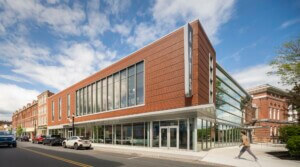The legacy of Henrietta Lacks, a Black woman from Baltimore County who underwent treatment for cervical cancer at Johns Hopkins University in the 1950s and whose cell samples still remain in use for scientific research, will live on with the construction of a new building at the prestigious research university’s East Baltimore Medical Campus. Plans for the facility were first announced by Johns Hopkins in 2018, with a design by North Carolina-based Vines Architecture unveiled late last week.
The Henrietta Lacks Research Building will rise directly adjacent to Deering Hall, a squat red brick building originally built in 1879 as a police station that for the past decade has housed the Berman Institute of Bioethics. Spanning 34,000 square feet, the new structure will include space for education and research in the form of classrooms and meeting rooms that can be used by the university and the larger East Baltimore community.
Renderings by Vines Architecture detailing the proposed design show two connected structures with transparent facades. The taller building features a criss-crossing pattern across its main face, while the smaller one, designed with a more linear grid on its front elevation, has a landscaped rooftop.
“The expression of this building is unique to its surroundings, as Henrietta Lacks was a unique African American human being in this world. Our team has worked to design a building that fits within the urban context but has a special identity that we hope people believe warrants carrying the name of Henrietta Lacks,” said Vines Architecture president Victor Vines and director of design Robert Thomas in a statement. “As we continue progress on the design, we believe that this building will remain a critical way to share the story of Henrietta Lacks for generations to come.”
In conceiving the new building, the university and Vines Architecture team worked closely with surviving relatives of Lacks to create a design not only worthy of her contribution to science and medicine, but also a place that embodies who she was.
“It is exciting to know what the building named in honor of my grandmother, Henrietta Lacks, will look like from the outside captivating her legacy. I’m happy to see it presented to the Baltimore community,” said Jeri Lacks Whye, who serves as a member of the Henrietta Lacks Building Advisory Committee alongside four other family members along with East Baltimore residents and university officials. “The design reflects not only her strong and beautiful spirit but her important role she plays in the history, and future, of East Baltimore.”
Although Lacks, who was born in Virginia and moved to Baltimore County in the 1940s, ultimately passed away in 1951 from her illness, the cells taken from her body—known today simply as HeLa cells—during a biopsy were capable of remarkably fast duplication, and have thus lived on. Her legacy was the subject of the 2010 book The Immortal Life of Henrietta Lacks; the book was later adapted into an HBO television film of the same name starring and co-produced by Oprah Winfrey.
In the decades since Lacks’ cells were sequestered (without consent or compensation to the family as was standard practice at the time), the HeLa cell line has allowed for the research of numerous medicinal and technological advances including the development of vaccines for viruses such as polio and COVID-19, as well as the research of AIDS and cancers. The cell line was even were used for the study of zero gravity. Lack’s cells not only laid a foundation for biological research and advancement, but also prompted a discussion surrounding the ethics of how one’s body parts are used by the scientific community. In 2013, Johns Hopkins, the Lacks Family, and the National Institutes of Health arranged that scientists could no longer freely use Lack’s cells and her “genetic blueprint,” and must instead obtain permission.
Further approvals are required for the planned building following an initial meeting that presented the design to the Urban Design and Architecture Advisory Panel of the Baltimore City Planning Department.
“The architectural design of the building to be named for Henrietta Lacks reflects Johns Hopkins’ commitment to proudly honor and celebrate Mrs. Lacks’ extraordinary legacy on our campus,” added Ronald Daniels, president of Johns Hopkins University. “We are excited to share these plans with the city’s design and architecture advisory panel, and we look forward to continuing to work closely with the Baltimore community and the family of Henrietta Lacks as this important project moves forward.”
The university and design team anticipate design work to continue through to the end of the year, with completion slated for 2025.











